 Website:
Siglent Technologies Co., Ltd
Website:
Siglent Technologies Co., Ltd
Catalog excerpts
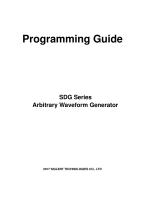
Programming Guide SDG Series Arbitrary Waveform Generator
Open the catalog to page 1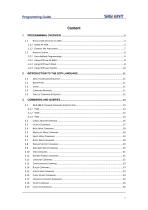
Programming Guide
Open the catalog to page 3
Programming Guide 1 Programming Overview By using USB and LAN interfaces, in combination with NI-VISA and programming languages, users can remotely control the waveform generator. Through LAN interface, VXI-11, Sockets and Telnet protocols can be used to communicate with the instruments. This chapter introduces how to build communication between the instrument and the PC. It also introduces how to configure a system for remote instrument control. Build communication via VISA 1.1.1 Install NI-VISA Before programming, please make sure that you have properly installed the latest version of...
Open the catalog to page 5
Programming Guide c. Click Unzip, the install process will launch after unzipping files. If your computer needs to install the .NET Framework 4, it may auto start. d. The NI-VISA install dialog is shown above. Click Next to start the installation process.
Open the catalog to page 6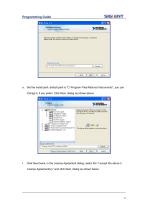
Programming Guide e. Set the install path, default path is “C:\Program Files\National Instruments\”, you can change it, if you prefer. Click Next, dialog as shown above. Click Next twice, in the License Agreement dialog, select the “I accept the above 2 License Agreement(s).”,and click Next, dialog as shown belo
Open the catalog to page 7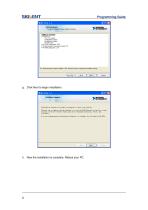
Programming Guide g. Click Next to begin installation. h. Now the installation is complete. Reboot your PC.
Open the catalog to page 8
Programming Guide 1.1.2 Connect the instrument Depending on the specific model, the arbitrary waveform generator may be able to communicate with a PC through the USB or LAN interface. Connect the arbitrary waveform generator and the USB Host interface of the PC using a USB cable. Assuming your PC is already turned on, turn on the SDG, and then the PC will display the “Device Setup” screen as it automatically installs the device driver as shown below. Wait for the installation to complete and then proceed to the next step.
Open the catalog to page 9
Programming Guide Remote Control 1.2.1 User-defined Programming Users can send SCPI commands via a computer to program and control the arbitrary waveform generator. For details, refer to the introductions in " Programming Examples". 1.2.2 Using SCPI via NI-MAX NI-MAX is a program created and maintained by National Instruments. It provides a basic remote control interface for VXI, LAN, USB, GPIB, and Serial communications. The SDG can be controlled remotely by sending SCPI commands via NI-MAX. 1.2.3 Using SCPI over Telnet Telnet provides a means of communicating with the SDG over the LAN....
Open the catalog to page 10
Programming Guide 4. At the Telnet command line, type: open XXX.XXX.XXX.XXX 5024 Where XXX.XXX.XXX.XXX is the instrument’s IP address and 5024 is the port. You should see a response similar to the following: 5. At the SCPI> prompt, input the SCPI commands such as *IDN? to return the company name, model number, serial number, and firmware version number.
Open the catalog to page 11
SIGUENT Programming Guide 6. To exit the SCPI> session, press the Ctrl+] keys simultaneously. 7. Type quit at the prompt or close the Telnet window to close the connection to the instrument and exit Telnet. 1.2.4 Using SCPI over Socket Socket API can be used to control the SDG series by LAN without installing any other libraries. This can reduce the complexity of programming. SOCKET ADDRESS IP address + port number IP ADDRESS SDG IP address Please see section 4.2 "Examples of Using Sockets" for the details.
Open the catalog to page 12
Programming Guide 2 Introduction to the SCPI Language 2.1 About Commands & Queries This section lists and describes the remote control commands and queries recognized by the instrument. All commands and queries can be executed in either local or remote state. Each command or query, with syntax and other information, has some examples listed. The commands are given in both long and short format at “COMMAND SYNTAX”and “QUERY SYNTAX”, and the subject is indicated as a command or query or both. Queries perform actions such as obtaining information, and are recognized by the question mark (?)...
Open the catalog to page 13
Programming Guide SIGUENT number of times.
Open the catalog to page 14
Programming Guide SIGUENT
Open the catalog to page 15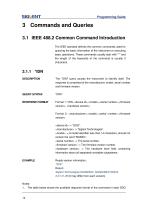
SIGUENT Programming Guide 3 Commands and Queries 3.1 IEEE 488.2 Common Command Introduction The IEEE standard defines the common commands used for querying the basic information of the instrument or executing basic operations. These commands usually start with "*" and the length of the keywords of the command is usually 3 characters. 3.1.1 *IDN DESCRIPTION The *IDN? query causes the instrument to identify itself. The response is comprised of the manufacturer, model, serial number and firmware version. QUERY SYNTAX *IDN? RESPONSE FORMAT Format 1: *IDN, <device id>,<model>,<serial...
Open the catalog to page 16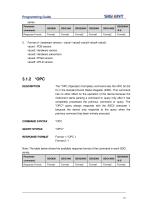
Programming Guide SIGUENT
Open the catalog to page 17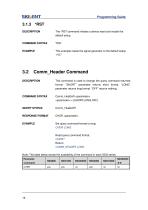
Programming Guide SIGUENT 3.1.3 *RST DESCRIPTION The *RST command initiates a device reset and recalls the default setup. COMMAND SYNTAX *RST EXAMPLE This example resets the signal generator to the default setup: DESCRIPTION This command is used to change the query command returned format. “SHORT” parameter returns short format. “LONG” parameter returns long format. “OFF” returns nothing. COMMAND SYNTAX Comm_HeaDeR <parameter> <parameter>:= {SHORT,LONG,OFF}. QUERY SYNTAX Comm_HeaDeR? RESPONSE FORMAT CHDR <parameter> EXAMPLE Set query command format to long: Read query...
Open the catalog to page 18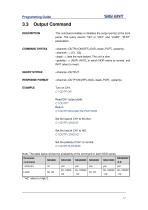
Programming Guide SIGUENT DESCRIPTION This command enables or disables the output port(s) at the front panel. The query returns “ON” or “OFF” and “LOAD”, “PLRT” parameters. COMMAND SYNTAX <channel>:OUTPut ON|OFF,LOAD,<load>,PLRT, <polarity> <channel> := {C1, C2}. <load> := {see the note below}. The unit is ohm. <polarity> := {NOR, INVT}, in which NOR refers to normal, and INVT refers to invert. QUERY SYNTAX <channel>:OUTPut? RESPONSE FORMAT <channel>:OUTP ON|OFF,LOAD,<load>,PLRT, <polarity> C1:OUTP ON Read CH1 output state: C1:OUTP? Return: C1:OUTP ON,LOAD,HZ,PLRT,NOR Set the...
Open the catalog to page 19All Siglent Technologies Co. catalogs and technical brochures
-
SDS6000A Series
21 Pages
-
SDS 7000A Series
21 Pages
-
SDL1000X Series
10 Pages
-
SSM5000A Series
15 Pages
-
Spectrum Analyzer Bandwidth
6 Pages
-
Siglent_Product Catalog 2016
48 Pages
-
Siglent Selection Guide 2016
10 Pages
-
Benefits of deep memory
3 Pages
-
SIGLENT Probes Datasheet
7 Pages
-
Siglent SDS2000X User Manual
197 Pages
-
Siglent SDS2000X Service Manual
59 Pages
-
Probe Data Sheet + Siglent
7 Pages
-
USB-GPIB User Manual_Siglent
13 Pages
-
ISFE User Manual
12 Pages
-
Siglent TrueArb Technology
9 Pages
-
SDS2000 VS DS2000A_EN_Siglent
10 Pages
-
SIGLENT SDS1000CFL
8 Pages
-
SIGLENT SHS800 Data Sheet
10 Pages









































































